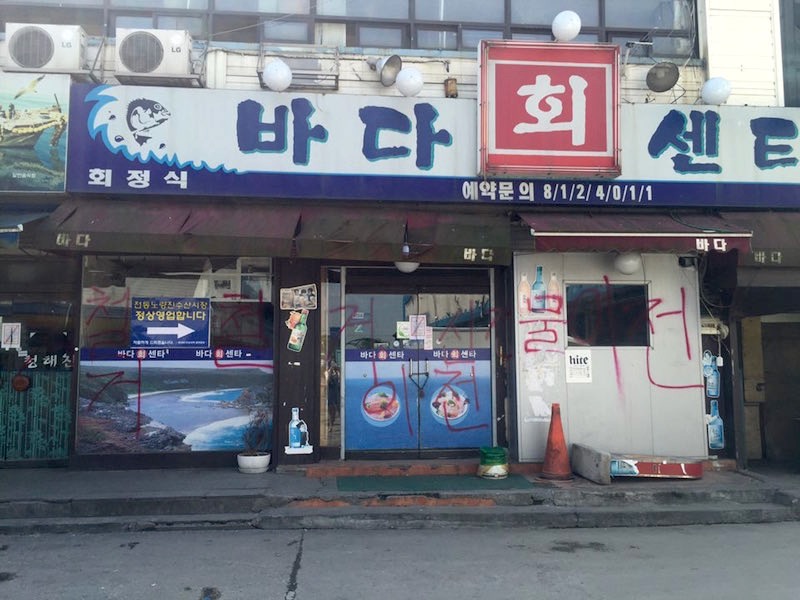
Changes at Famed Noryangjin Fish Market Ignite Struggle
These days any tourists or shoppers passing through Seoul’s Noryangjin Fisheries Wholesale Market will see a lot of red. Not just the red of the plastic slotted bins for sorting fish, the rubber gloves used for handing them or the deep flush of stacked sea pineapple.
In Noryangjin today red ribbons with yellow writing drape the hanging lamps of every stall and matching red vests sit on the shoulders of the vendors as they work. The red symbolizes protest by the Noryangjin vendors — specifically their refusal to abandon the existing market and move into a new market space erected just a few meters away.

The fight, between vendors and the developer of the site, has developed into full-blown war, attracting media scrutiny and casting doubt on the market’s continuing viability as Seoul’s mecca for seafood.
In operation at its current location since 1971, Noryangjin provides 45 percent of the seafood supply for the capital region, serving restauranteurs, small shop owners and ordinary customers in search of the best and the freshest. It is also a popular tourist attraction and has appeared in several movies and TV dramas.
But criticisms mounted over the aging interior and potential health hazards posed by what some saw as an unhygienic environment. Therefore, in 2004 the South Korean government formed a committee known as the Noryangjin Fish Market Modernization Project to improve the function and atmosphere of the site.
The government put Suhyup, the National Federation of Fisheries Cooperation, in charge of the modernization operation, and that’s when troubles began brewing.
Suhyup built a new building to serve the market, but in the two-month period since the deadline for some 600 vendors to move into the new building, only five percent leapt at the chance. Though the number has risen to reach more than half, many merchants accuse Suhyup of exerting undue pressure to facilitate the move.
Why the resistance? Why wouldn’t any vendor welcome the chance to move into an all-new, sparkling clean facility? The short answer from them is that the new market, completed in October 2015 and constructed largely through government funding, does not meet the vendors needs: The vending stalls are allegedly smaller and the quality of ventilation is questionable with a restricted number of first-floor entryways. It’s a significant contrast to the open-air plan enjoyed in the existing market space.
There is also concern about the trash-burning facility located in the basement which may heat up the building during summer months. Adding salt to the wound is the rent increase Suhyup is imposing on the vendors for moving into the new building — two to three times what they currently pay.
But there is more to why the “modernization” of the Noryangjin Fish Market is contested.
Suhyup, definitionally an organization intended to support the needs of vendors and distributors in the seafood business, was directed to communicate and work with Noryangjin vendors throughout the modernization project. According to the Noryangjin Fish Market Anti-modernization Emergency Alliance — a group composed of vendors and activists working to preserve the existing market — discussions between Suhyup and vendor representatives were rare and intentionally opaque.
“This, unfortunately, is an increasingly common theme in development,” said Kim Sang-chul, a member of South Korea’s Labor Party who is sympathetic toward the vendors. “A third party such as Suhyup is put in charge of a development project. The [vendors] have a lot of trust in the government to protect them and look out for their best interest.”
But that may have been wishful thinking. Not only has the new building disappointed vendors, they are particularly enraged by the report that Suhyup submitted to the Ministry of Culture last year a proposal to building a casino on the site of the old market. The ministry rejected the proposal but ill feelings linger.
While denying the claims made by the vendors over the inadequacy of the new building and justifying the higher rent, Suhyup apparently has taken to using some extreme measures to force the vendors out of the old building.
“Suhyup constantly threatens vendors with legal action in addition to physical threats. They vandalized an area with tables where vendors eat their lunch, and cut water and electricity to certain blocks of stalls,” Lee Chae-ho, a representative of the Emergency Alliance, said.
Yonhap News partly corroborated his assertion, reporting the selective water and electricity cut. Videos uploaded by an unverified source on YouTube show a plain-clothed man vandalizing a dining area of the market, against objections from vendors, as well as private security guards engaging in physical altercations with the merchant community.
https://www.youtube.com/watch?v=xGksqzC2T0I
Today the stairwells and shuttered businesses adjacent to the main market are scrawled in red spray paint, adding to the sense of shabbiness and decay at the old fish market. The word “Demolition” in red appears on the second floor of the old market where customers could once dine on their seafood purchases.
Lee says this is an effort to deter tourists and shoppers from visiting the old building and drive down sales, financially forcing the vendors out and into the new building.
Tensions are high. The Korea Herald reported that a vendor was arrested in April for attempting to stab a Suhyup representative with a knife. Vendors who remain in the old building make sure to occupy the area and the parking lot 24 hours a day in order to make sure Suhyup does not begin bulldozing without notice.

One female vendor described her decision to move and how the change has impacted her business, on condition of anonymity: “We had to move, for me it wasn’t a choice, they didn’t give us a choice. We move now or we move later. I wanted to get on with my business. I’m still missing some of my regular customers, but I believe they’ll come eventually.”
Vendors with the Emergency Alliance have no plans to abandon occupation of the old market and, according to Lee, are hopeful for a positive government intervention. The Emergency Alliance has made contact with the National Assembly, which has scheduled a hearing for next month.
Kim, of the Labor Party, said, “The government holds the key to resolving this in a way that favors the vendors. Without a government-led resolution tensions will continue to increase at the site of the existing market and the market will collapse.”

